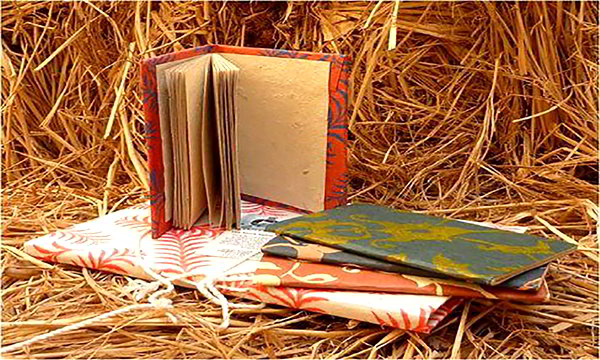Imagine you’re sitting there, a stack of rice straw in front of you. You’re about to take something simple, something that’s usually seen as waste, and transform it into something beautiful and useful: paper. It’s a bit like life, right? We all have the raw materials around us; it’s what we do with them that makes the difference. With a very minimal capital, this agricultural waste could be a good source of livelihood.
Children can make paper from rice straw in their homes or as a project in the community. Since ancient times, artisans in China and Japan have practiced the art of paper-making, producing different types of paper such as glossy and silky ones.
Here’s how you can do it—not just follow a recipe, but really make something. A commitment, not just to the task but to the process. This isn’t fast, it isn’t easy, but that’s part of the point. The best things rarely are.

Paper from Rice Straw
Use the following materials:
1. Wooden mold
2. Cooking pot
3. Weighing scale
4. Box with 100 inch screen for working the rice straw.
5. 50 inch screen metal strainer in a wooden frame for separating waste from the melted rice straw.
6. Soak the mold with mixed rice straw and water in a plastic or metal basin or any big container until it melts.
7. Wood to grind the cooked straw.
8. Rolling pin to remove water from the melted straw.
9. Choose cloth to drain water from straw in the mold.
10. Wooden press – to drain water during molding of the cooked straw.
11. Workers lay the produced paper to dry on a wooden drier.
12. In the absence of a wooden drier, you can pin the produced paper in cheese cloth and hang it on a cloth line to dry.
13. Chemicals and other materials:
Sodium hydroxide – to soften the rice straw during cooking
Rosin size and alum – to prevent excessive absorption of water and blotting of the dye.
Sodium hypochlorite – for bleaching of paper (if desired)
A. Preparation of Rice Straw
- Cutting and Washing:
- Cut rice straw into 5 cm pieces to ensure even cooking and easier grinding.
- Washing the straw removes impurities and dirt that could affect paper quality.
- Cooking the Rice Straw:
- Straw Quantity: Use 1 kg of dried rice straw.
- Sodium Hydroxide Solution: Dissolve 210 grams of 95% pure sodium hydroxide in 19 liters of water.
- The sodium hydroxide softens the straw fibers, allowing them to break down more effectively.
- Cooking Time: Boil the straw-sodium hydroxide solution for 2 hours to fully dissolve and soften the fibers.
- Grinding the Fibers:
- After cooking, you should grind or pound the straw. You can do this with a wooden mallet on a hard surface or with a mortar and pestle. This helps to break down the fibers further.
- After grinding, straining through a 50-mesh and a 100-mesh screen removes larger waste, leaving behind a finer pulp.
B. Bleaching
- Sodium Hypochlorite Solution:
- If you desire a lighter color, dissolve 400 grams of sodium hypochlorite in 1 liter of water to bleach the pulp.
- Soaking Time: Allow the pulp to soak in this solution for a duration depending on the desired brightness, typically around 15-30 minutes.
- Forming and Sizing:
- Rosin Size Solution: Dissolve 10 grams of rosin size in 100 ml of boiling water (to create a 10% solution).
- Alum Solution: Dissolve 20 grams of alum in 100 ml of boiling water (for a 20% solution).
- Add both solutions to the pulp mix. Rosin size reduces water absorption, and alum prevents blotting of dye when coloring the paper.
- Creating Pulp Thickness and Paper Formation:
- Add water to the basin according to the desired thickness of the paper.
- For a pulp basin size of 10? x 14? x 0.045?, add approximately 20 liters of water for a moderate thickness.
- Molding: Submerge the wooden mold in the basin and move it to distribute the pulp evenly, ensuring uniform thickness.
C. Drying and Final Processing
- Pressing and Draining Water:
- Use a rolling pin or wooden press to expel excess water.
- Placing cheesecloth between the paper layers helps prevent sticking during the drying process.
- Drying:
- Allow the sheets to air dry either on a wooden drier or by hanging on a clothesline with cheesecloth backing.
Summary of Measurements and Proportions:
| Step | Material | Quantity |
|---|---|---|
| Cooking | Rice Straw | 1 kg |
| Cooking | Sodium Hydroxide | 210 grams in 19 liters of water |
| Bleaching | Sodium Hypochlorite | 400 grams in 1 liter of water |
| Sizing | Rosin Size | 10 grams in 100 ml boiling water (10%) |
| Sizing | Alum | 20 grams in 100 ml boiling water (20%) |
| Pulp Basin | Water | Approx. 20 liters |


???????????????????????????????????????????????????????????????????????????24????????0884255017-0829443659????????????????????????